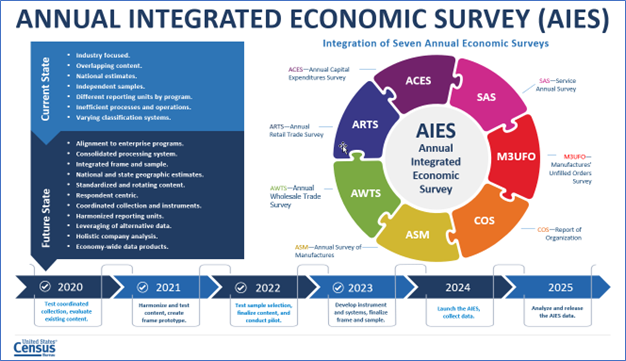Press Release Number: CB24-TPS.102
OCT. 10, 2024 — The U.S. Census Bureau today released new data products from the Business Trends and Outlook Survey (BTOS), a survey that measures business conditions and projections on an ongoing basis. The BTOS includes data for multiunit/multilocation businesses. BTOS will continue to collect data complementary to key items found on other Economic surveys, such as revenues, employees, hours, and inventories. Additional details on artificial intelligence use and types used were added for one cycle and released March 28, 2024.
BTOS data are representative of all employer businesses in the U.S. economy, excluding farms. BTOS provides insight into the state of the economy by providing continuous, timely data for key economic measures every two weeks. By providing continuous data with geographic and subsector detail, BTOS captures the impact of events like natural disasters and economic crises, and assists in monitoring recovery efforts.
The BTOS sample consists of approximately 1.2 million businesses with biweekly data collection. Selected businesses are split into six panels (approximately 200,000 cases per panel) that will be asked to report every 12 weeks for a year. The Census Bureau estimates it takes the average respondent approximately nine minutes to complete the survey, including the time for reviewing the instructions and answers.
Data will be released biweekly and available by sector, state and the 25 most populous metropolitan statistical areas. Survey results give local, state and federal officials essential, real-time data to aid in policymaking and decision-making. In addition, the information aids businesses in making economic decisions.
No news release associated with this announcement. Tip sheet only.
###



Press Release Number: CB25-TPS.27
APRIL 24, 2025 — The U.S. Census Bureau today released new data products from the Business Trends and Outlook Survey (BTOS), a survey that measures business conditions and projections on an ongoing basis. The BTOS includes data for multiunit/multilocation businesses. BTOS will continue to collect data complementary to key items found on other economic surveys, such as revenues, employees, hours, and inventories.
Work from home (WFH) supplemental questions were added to the BTOS for one cycle (11/4/2024-1/26/2025). Existing measures of WFH reveal significant data gaps in understanding its scope, particularly from the business perspective. To address this, eleven WFH questions were developed for the BTOS, covering the share and frequency of WFH, challenges, management policies, and business impact. These data are now available.
BTOS data are representative of all employer businesses in the U.S. economy, excluding farms. BTOS provides insight into the state of the economy by providing continuous, timely data for key economic measures every two weeks. By providing continuous data with geographic and subsector detail, BTOS captures the impact of events like natural disasters and economic crises and assists in monitoring recovery efforts.
The BTOS sample consists of approximately 1.2 million businesses with biweekly data collection. Selected businesses are split into six panels (approximately 200,000 cases per panel) that will be asked to report every 12 weeks for a year. The Census Bureau estimates it takes the average respondent approximately nine minutes to complete the survey, including the time for reviewing the instructions and answers.
Data will be released biweekly and available by sector, state and the 25 most populous metropolitan statistical areas. Survey results give local, state and federal officials essential, real-time data to aid in policymaking and decision-making. In addition, the information aids businesses in making economic decisions.
No news release associated with this announcement. Tip sheet only.
###
Commenting on blog posts requires an account.
Login is required to interact with this comment. Please and try again.
If you do not have an account, Register Now.